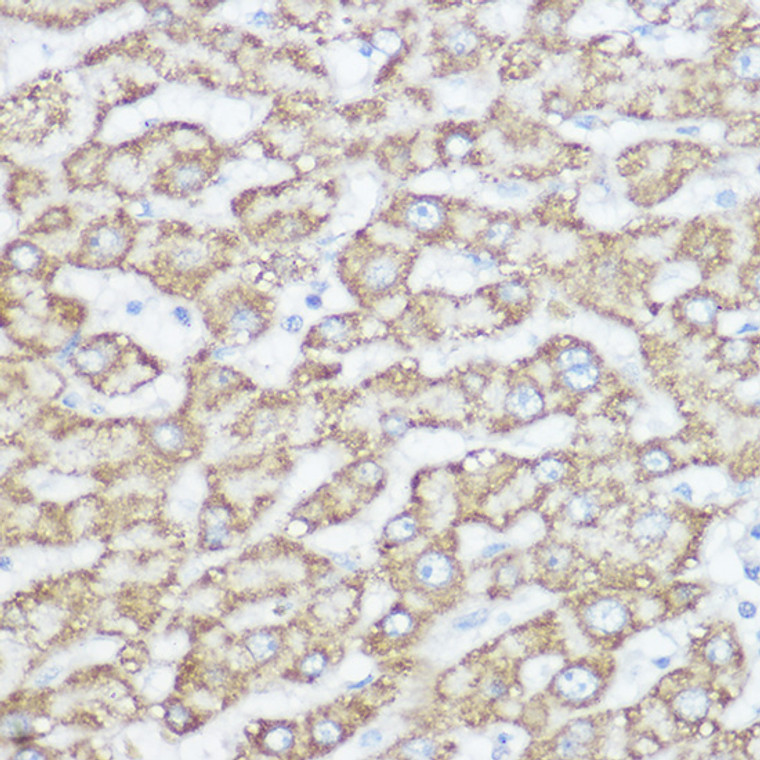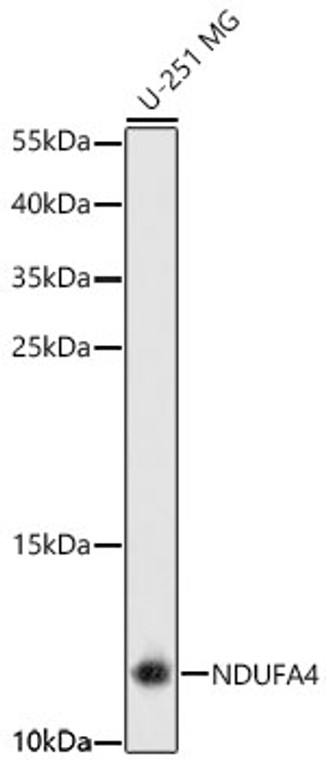| Host: |
Rabbit |
| Applications: |
WB/IHC/IF |
| Reactivity: |
Human/Mouse/Rat |
| Note: |
STRICTLY FOR FURTHER SCIENTIFIC RESEARCH USE ONLY (RUO). MUST NOT TO BE USED IN DIAGNOSTIC OR THERAPEUTIC APPLICATIONS. |
| Short Description: |
Rabbit polyclonal antibody anti-NDUFA4 (1-81) is suitable for use in Western Blot, Immunohistochemistry and Immunofluorescence research applications. |
| Clonality: |
Polyclonal |
| Conjugation: |
Unconjugated |
| Isotype: |
IgG |
| Formulation: |
PBS with 0.01% Thimerosal, 50% Glycerol, pH7.3. |
| Purification: |
Affinity purification |
| Dilution Range: |
WB 1:500-1:2000IHC-P 1:100-1:500IF/ICC 1:50-1:100 |
| Storage Instruction: |
Store at-20°C for up to 1 year from the date of receipt, and avoid repeat freeze-thaw cycles. |
| Gene Symbol: |
NDUFA4 |
| Gene ID: |
4697 |
| Uniprot ID: |
NDUA4_HUMAN |
| Immunogen Region: |
1-81 |
| Immunogen: |
Recombinant fusion protein containing a sequence corresponding to amino acids 1-81 of human NDUFA4 (NP_002480.1). |
| Immunogen Sequence: |
MLRQIIGQAKKHPSLIPLFV FIGTGATGATLYLLRLALFN PDVCWDRNNPEPWNKLGPND QYKFYSVNVDYSKLKKERPD F |
| Function | Component of the cytochrome c oxidase, the last enzyme in the mitochondrial electron transport chain which drives oxidative phosphorylation. The respiratory chain contains 3 multisubunit complexes succinate dehydrogenase (complex II, CII), ubiquinol-cytochrome c oxidoreductase (cytochrome b-c1 complex, complex III, CIII) and cytochrome c oxidase (complex IV, CIV), that cooperate to transfer electrons derived from NADH and succinate to molecular oxygen, creating an electrochemical gradient over the inner membrane that drives transmembrane transport and the ATP synthase. Cytochrome c oxidase is the component of the respiratory chain that catalyzes the reduction of oxygen to water. Electrons originating from reduced cytochrome c in the intermembrane space (IMS) are transferred via the dinuclear copper A center (CU(A)) of subunit 2 and heme A of subunit 1 to the active site in subunit 1, a binuclear center (BNC) formed by heme A3 and copper B (CU(B)). The BNC reduces molecular oxygen to 2 water molecules unsing 4 electrons from cytochrome c in the IMS and 4 protons from the mitochondrial matrix. NDUFA4 is required for complex IV maintenance. |
| Protein Name | Cytochrome C Oxidase Subunit Ndufa4Complex I-MlrqCi-MlrqNadh-Ubiquinone Oxidoreductase Mlrq Subunit |
| Database Links | Reactome: R-HSA-5628897Reactome: R-HSA-611105Reactome: R-HSA-9707564 |
| Cellular Localisation | Mitochondrion Inner MembraneSingle-Pass Membrane Protein |
| Alternative Antibody Names | Anti-Cytochrome C Oxidase Subunit Ndufa4 antibodyAnti-Complex I-Mlrq antibodyAnti-Ci-Mlrq antibodyAnti-Nadh-Ubiquinone Oxidoreductase Mlrq Subunit antibodyAnti-NDUFA4 antibody |
Information sourced from Uniprot.org
12 months for antibodies. 6 months for ELISA Kits. Please see website T&Cs for further guidance








